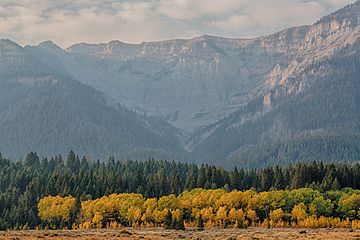Centennial Mountains facts for kids
Quick facts for kids Centennial Mountains |
|
|---|---|
 |
|
| Highest point | |
| Peak | Mount Jefferson (Bitterroot Range) |
| Elevation | 10,216 ft (3,114 m) |
| Geography | |
| Country | United States |
| Parent range | Bitterroot |
The Centennial Mountains are a mountain range found in the United States states of Idaho and Montana. They are the southernmost part of the larger Bitterroot Range. This mountain range is special because it runs from west to east, which is unusual for the Rocky Mountains. The Continental Divide, which separates rivers flowing to the Atlantic from those flowing to the Pacific, runs right along the top of these mountains. The highest point in the Centennial Mountains is Mount Jefferson.
Contents
Where are the Centennial Mountains?
This range stretches about 48 km (30 mi) from Monida Pass in the west to Henrys Fork in the east. It is bordered by Beaver Creek to the west and the Centennial Valley and Henrys Lake Mountains to the north. To the east, you'll find Henrys Lake Flat, and to the south, the Shotgun Valley and the Snake River Plain.
Western and Eastern Parts
The Centennial Mountains are divided into two main parts: the Western and Eastern Centennial Mountains. The Western part extends from the Eastern part along the Continental Divide to Monida Pass. It is about 25 mi northeast of Dubois, Idaho.
Nature and Wildlife
A large part of the Centennial Mountains, about 100,000 acres, has no roads. This makes it a very wild and untouched area. These roadless areas include land managed by the National Forest, the Bureau of Land Management's Centennial Mountains Primitive Area, and parts of the Red Rock Lakes National Wildlife Refuge. There are also some state and private lands, and a special research station for sheep.
Plants and Animals
The Centennial Mountains are home to many different kinds of plants. Scientists have found about 326 different types of vascular plants here. This is a lot of plant variety for the Greater Yellowstone Ecosystem region.
The area is also important for animals. Grizzly bears live here, along with almost all the other animals that naturally live in the Greater Yellowstone Ecosystem. The northern side of the Centennials rises sharply, about 3,000 feet, above the Centennial Valley. This creates a dramatic landscape for these animals.


